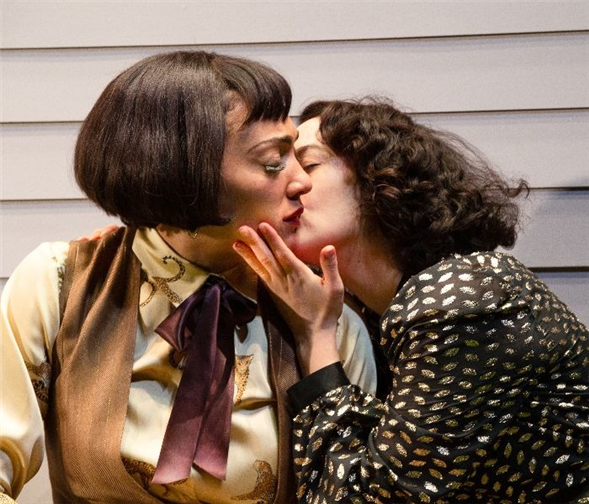Translate Page

María Irene Fornés' Fefu and Her Friends is finally being revived after four-plus decades
---
Like many admirers of María Irene Fornés' rarely performed masterpiece, director Lileana Blain-Cruz discovered Fefu and Her Friends in school. However, unlike many fellow fans, she didn't understand why the pioneering work by the late avant-garde playwright wasn't mounted more often. So Blain-Cruz decided to do something about that.
Thanks to her tenacity and Theatre for a New Audience in Brooklyn, Fefu and Her Friends is receiving its first professional New York production since its Off-Broadway premiere in 1977. Experiencing this play -- which is more often studied than staged -- reaffirms how daring and ahead of its time the show and its creator were.
Set in 1935 in a well-appointed New England country house, Fefu and Her Friends starts out with the title character and seven of her pals coming together to plan an educational fundraiser. The fact that the play is populated exclusively by women who discuss their hopes, desires and the ways the patriarchy restricts them was audacious for its era. But the structure of Act II is what made the play revolutionary.
The audience is invited on stage and organized into four groups that travel from room to room to watch four different vignettes. The scenes are performed at the same time, and everyone sees them all, just in different orders. Although we call this immersive or promenade theatre today, there was no term for it back then. It's an incredibly intimate experience that feels almost voyeuristic as the history of the women's relationships are revealed and new alliances are formed in the kitchen, library, guest bedroom and backyard. Finally, the entire audience reunites in the living room to witness the day's -- and the play's -- conclusion.
"There's no one authoritative perspective," says Blain-Cruz. "All of these different scenes are happening simultaneously and -- depending on what scene you start with -- you have a different experience of the show. Fornés was doing this before anyone was doing it, which is amazing. When we look at what happens in theatre trends now, people are moving around. She thought of this before, and that's really exciting to me."
{Image1}
To present the overlapping scenes, Blain-Cruz, in collaboration with scenic designer Adam Rigg, established a circular route, which she says mirrors the structure of Fornés' script. "She's not doing a build to a climax and then a denouement," Blain-Cruz explains. "She's purposefully operating circularly. There is a musicality in the structure, a kind of interconnectedness in the timing of the way those four scenes play simultaneously."
Amelia Workman, who portrays Fefu, says the play is thrilling because Fornés refuses to spoon-feed audiences. "It doesn't tell you what it's about," she says. "It forces you to do a lot of thinking on your own. Everything in the play is designed to make you constantly remember that you're a living being in space and anything could happen. In the same way that every character's journey is entirely different, I think everyone's experience of the show is so individual. It really shows the contents of their minds when audiences talk to you after about what they saw. "
Fefu and Her Friends debuted 42 years ago, and takes place 42 years before that. Yet Blain-Cruz says its story feels particularly urgent since it grapples with issues such as female kinship, sexual orientation and women's control over their own bodies.
"Fornés was deeply investigating the relationships of women," Blain-Cruz says. "If there were ever a time when we needed to make more space for that -- to actually investigate the complexities of those relationships as opposed to the stereotypes or archetypes that we tend to place people in -- it's now.
Blain-Cruz won't call Fefu and Her Friends a feminist play as she finds that limiting. Instead, she quotes Fornés, who dubbed it "'pro-feminine.' I love that description because she was basically saying women are human beings. She refused to be categorized by a world that is obviously insane. I think to try to be like, 'It's this,' is antithetical to someone who was like, 'We are so much more complicated than the labels you try to place upon us.'"
---
Carey Purcell writes about pop culture and politics for Vanity Fair, Politico and other publications, and blogs at CareyPurcell.com.
Top image: Amelia Workman and Helen Cespedes in Fefu and Her Friends. Photos by Henry Grossman.
TDF MEMBERS: Go here to browse our latest discounts for dance, theatre and concerts.